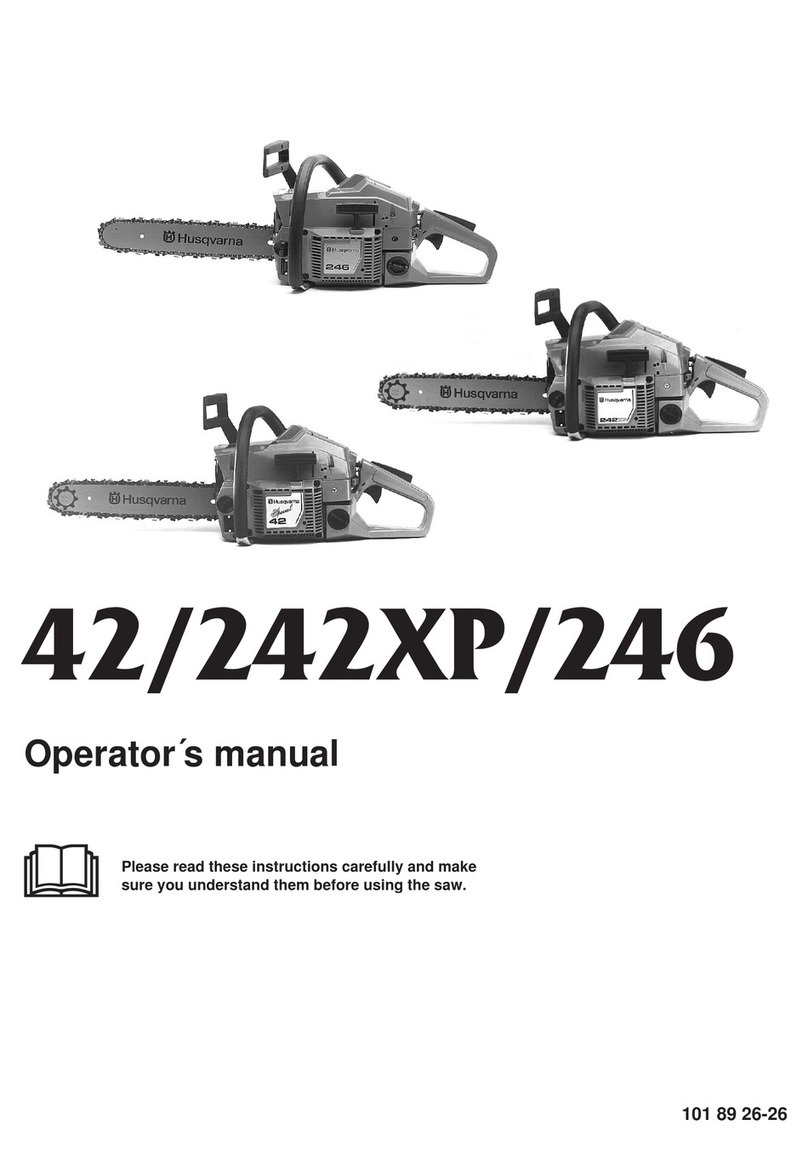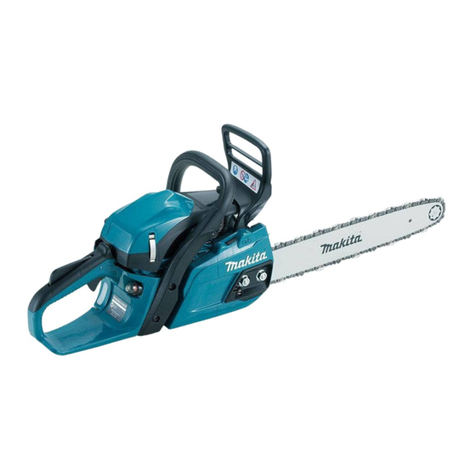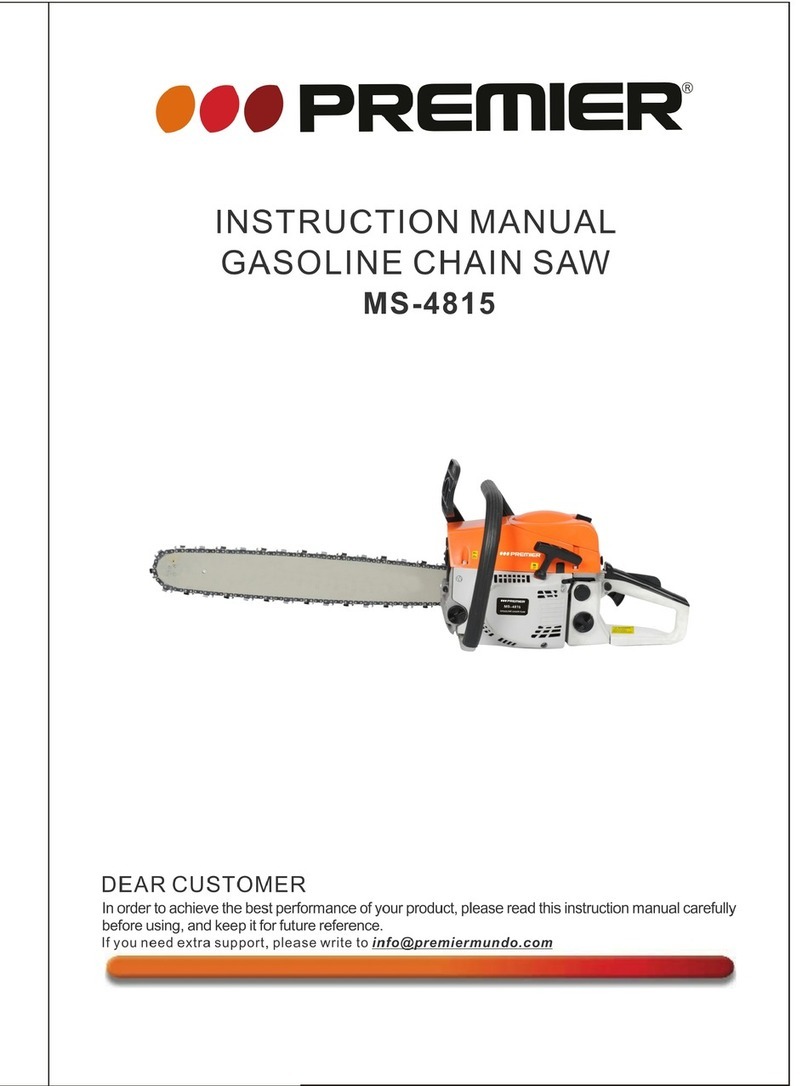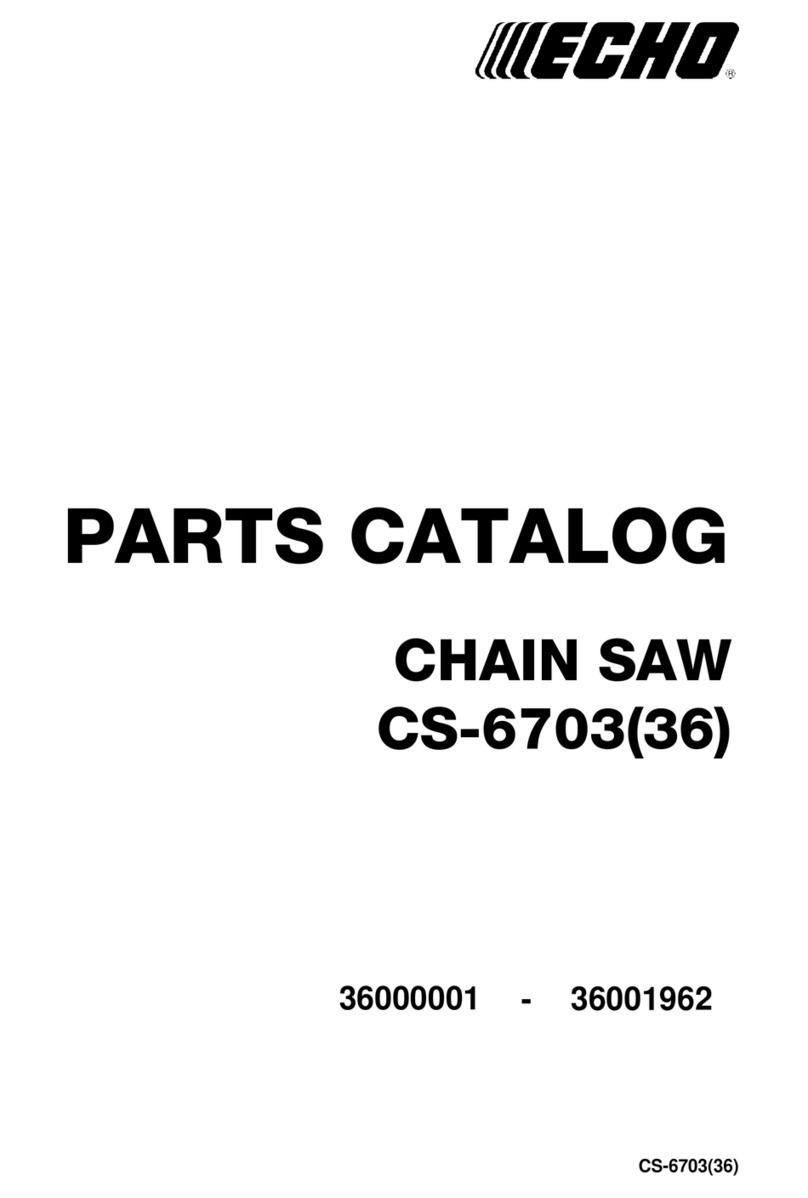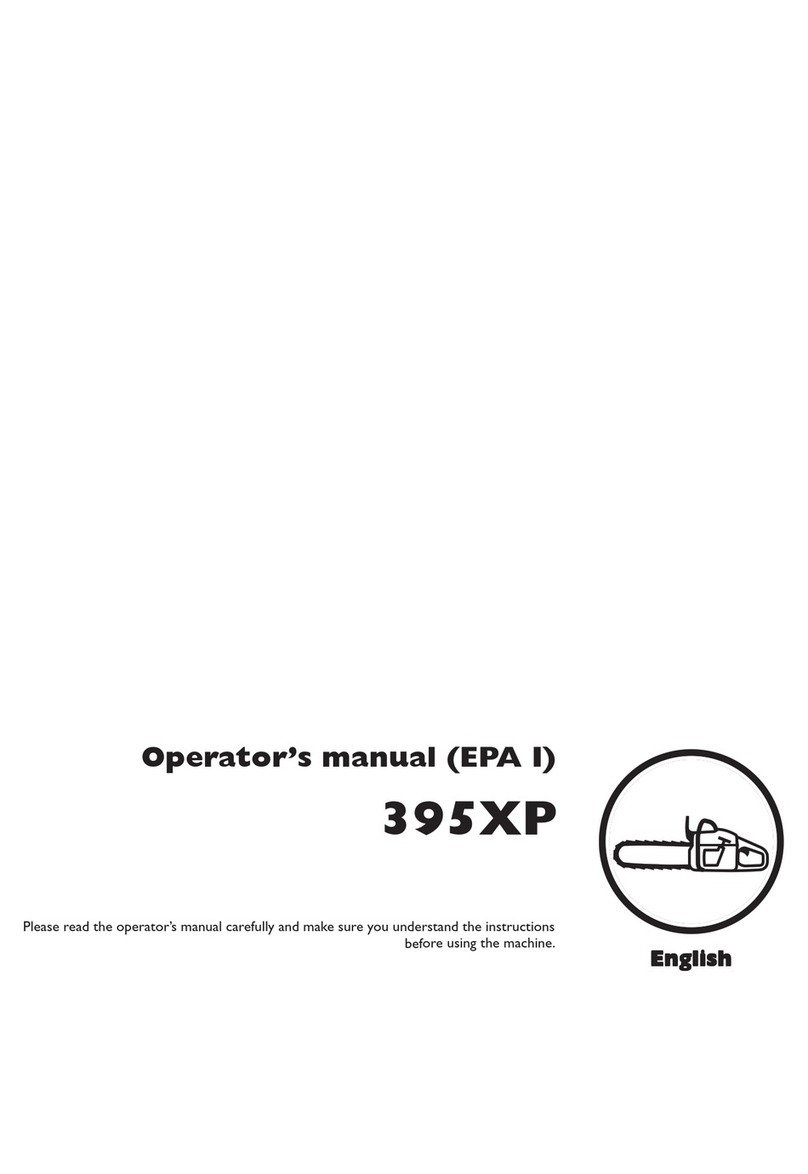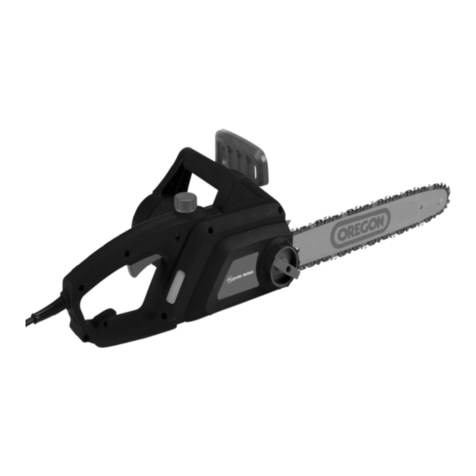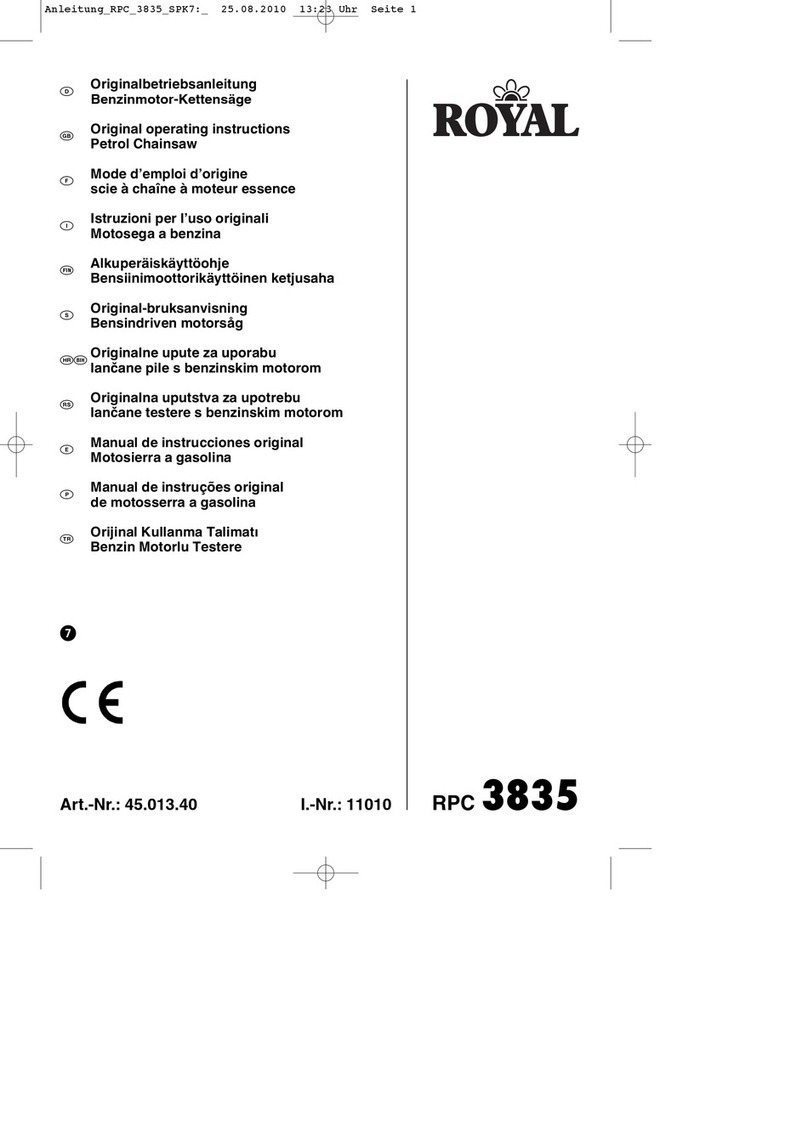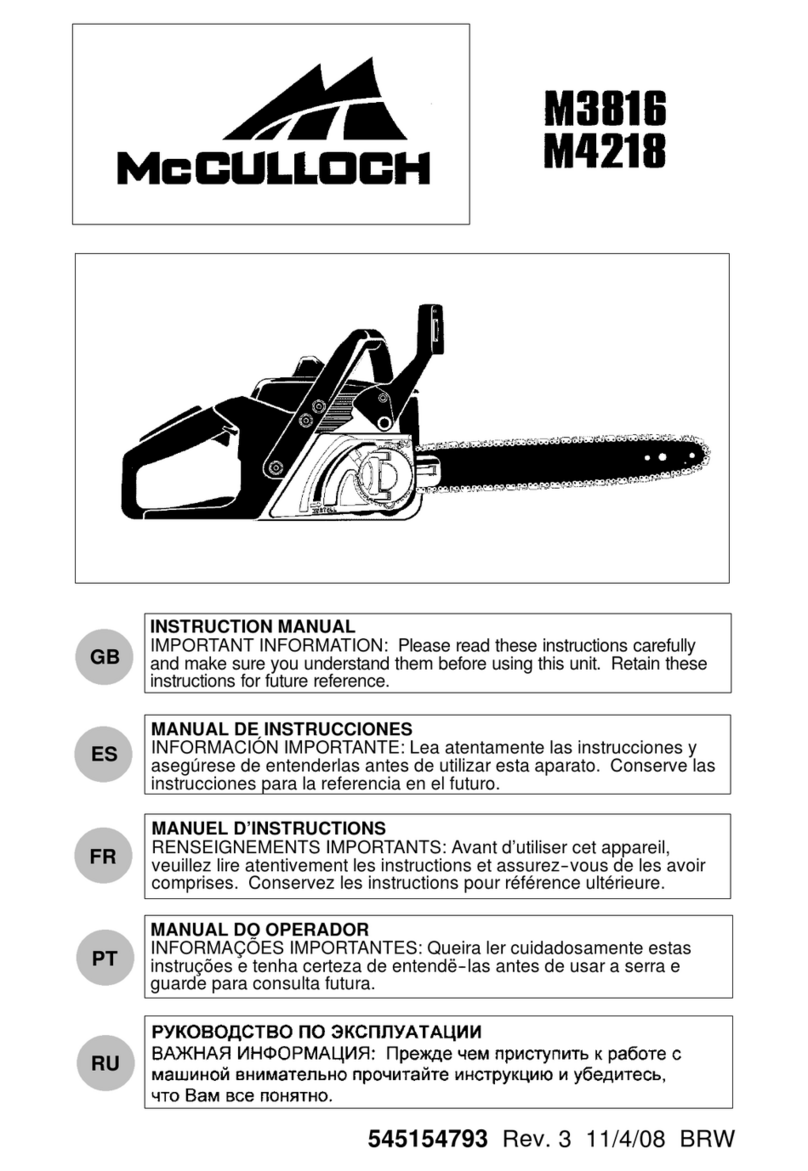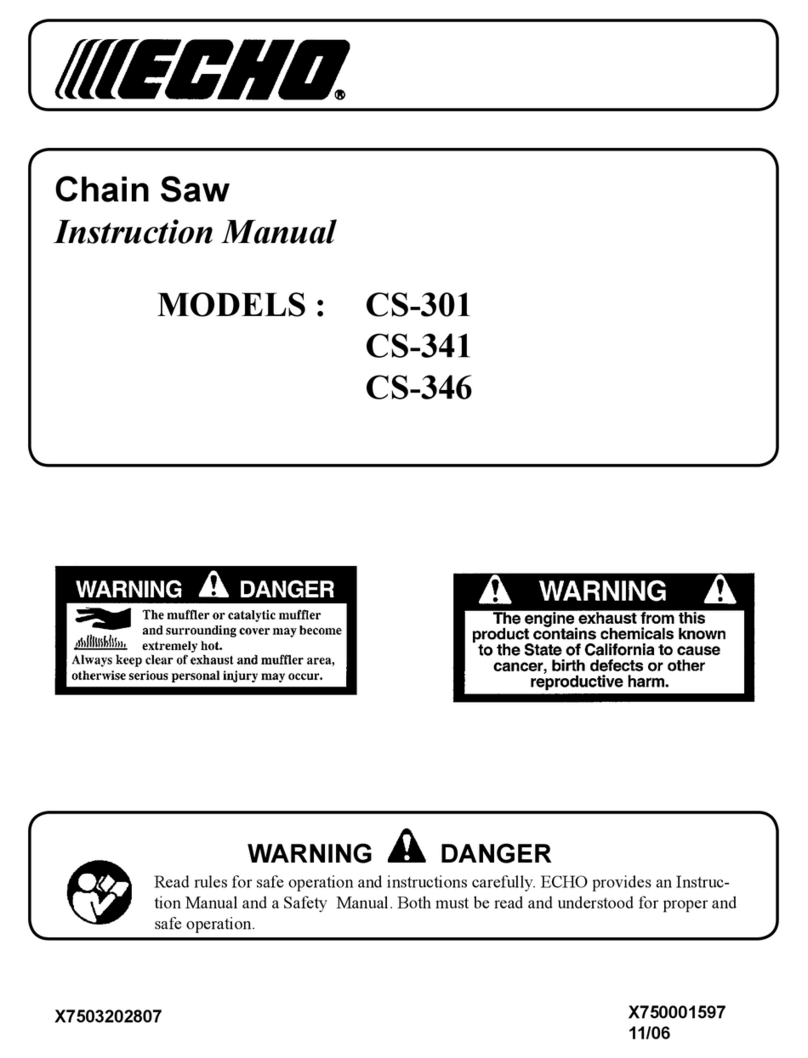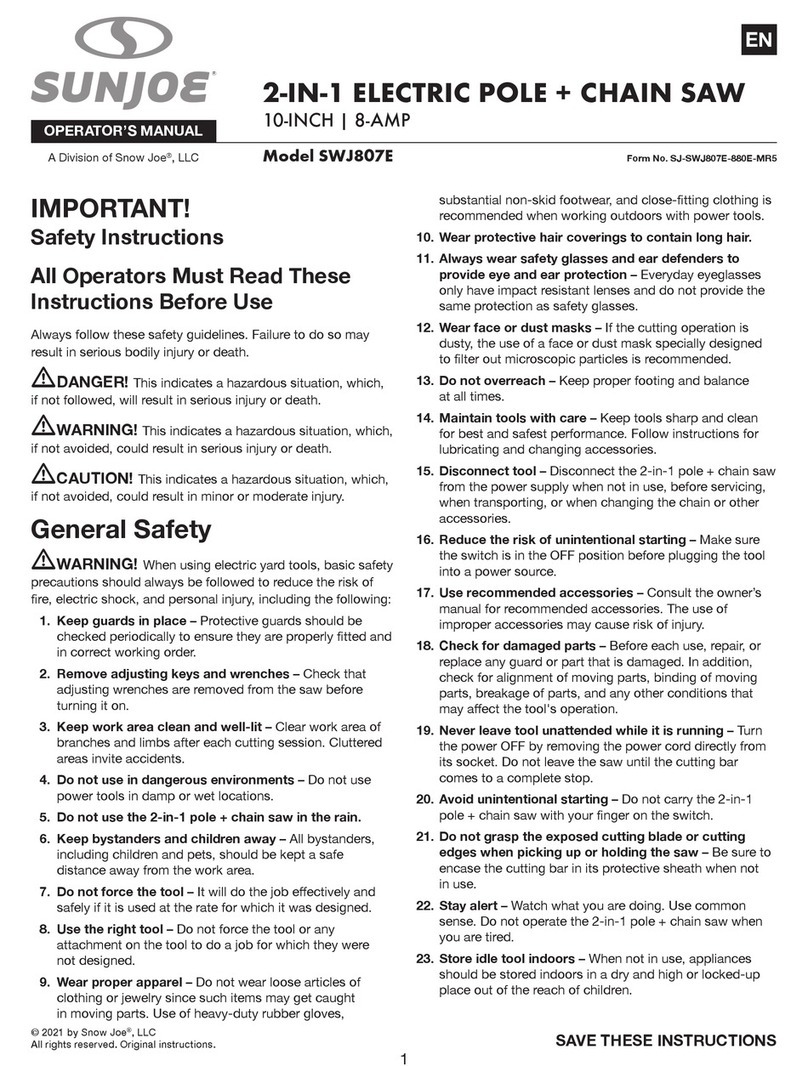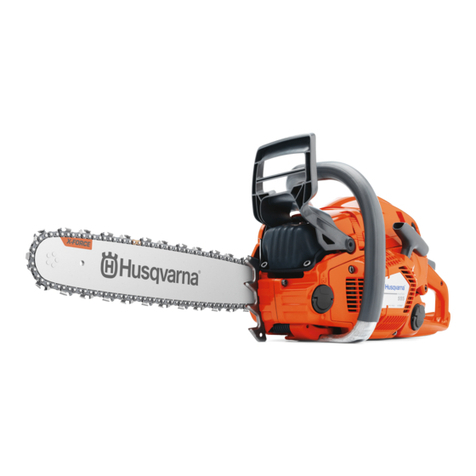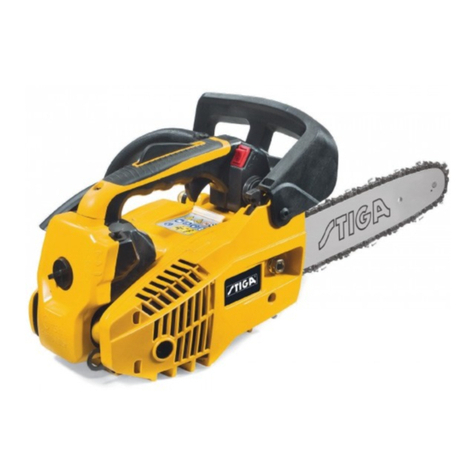Feider FELPRO25 User manual

ORIGINAL INSTRUCTIONS
1
INSTRUCTION MANUAL
PETROL PRUNING CHAIN SAW
FELPRO25
BUILDER SAS
32, rue Aristide Bergès -ZI 31270 Cugnaux –France
Warning: read the following instructions before using the machine
Made in Chine - 2020

ORIGINAL INSTRUCTIONS
2
CONTENTS
1. SAFETY WARNINGS 3
2. YOUR PRODUCT 7
3. ASSEMBLY 9
4. FILLING THE FUEL TANK 11
5. OPERATION 12
6. MAINTENANCE AND STORAGE 19
7. DECLARATION OF CONFORMITY 23

ORIGINAL INSTRUCTIONS
3
1. SAFETY WARNINGS
WARNING! When using this type of garden tool, basic precautions should always be followed to reduce the risk of
fire, electric shock and injury.
Read all instructions carefully before attempting to use this product and retain these instructions. Be familiar with
all the operations described in these operating instructions. This product must be operated by experienced users.
Inexperienced users shall first be trained in all operations by a professional.
If you are giving this machine to others, please also provide them with this instructions manual.
Take into account all the markings affixed to the product (symbols, labels, technical information, etc.). The
symbols are explained in this manual.
Use this machine as described in this instruction manual. It is strictly forbidden to use this tool for applications
other than those described in this manual.
Failure to follow these instructions can result in serious injuries and, in some cases, death.
This product is intended for private domestic use only. Do not use it for commercial purposes.
Never let people unfamiliar with these instructions or children use this product.
National regulations may limit the use of the machine.
People under the age of 18 must not use this product
Keep in mind that the operator or user is responsible for accidents or risks to other persons or their property.
Do not use the tool if you are drunk, tired, under the influence of drugs or ill. Do not use the tool if you are not in
an adequate physical condition.
This tool is intended for outdoor use. Never use it indoors.
When transporting the machine:
oSecure the machine during transport to prevent loss of fuel, damage or injury.
oUse a carrying case to protect the cutter during transport.
Keep people and animals away from the work area. Children and people who do not know how to use this tool
should not touch it and handle it.
Keep them at least 15 m from the machine during operation,
Use the product only under daylight or under good artificial light.
When using the machine, always wear full protective equipment including a helmet, protective mask, ear
protection, gloves, non-slip footwear and protective clothing.
Wear appropriate clothing. Do not wear loose or unbuttoned shirts. Do not wear jewellery that may come in
contact with moving parts. If you have long hair, tie it down and wear an appropriate safety helmet.
Do not operate the product with damaged guards or shields in place.
Keep hands and feet of the appliance at all times and especially when turning the appliance off and on.
Do not use the tool in an area where ventilation is poor. Gas emissions can cause injury.
Do not use the tool in the presence of flammable liquids or gases.
Caution: The machine releases gases when it is used. Avoid coming into contact with these gases.
Keep the work area clear. Before working, inspect the work area and remove any materials or objects that could
cause accidents.
Do not force the tool.
Use only accessories supplied or recommended by the manufacturer (such as saw chain and guide bar
combinations). Using other accessories may cause an accident. Refer to the “Technical Information” section of
this manual or ask your dealer for advice.
The risks of slipping and skidding must be foreseen as there is a high risk of kickback. Do not lean. Keep a good
balance at all times. Do not lose your balance at the end of a cut.
Always inspect the machine before and after operation. If the tool is damaged or faulty, stop using the tool and
bring it to an authorized service for inspection and repair.
Turn off the tool after use, when you leave it unattended, when changing these accessories and before servicing.
Be concentrated when using the tool. Look at what you do, use good sense and do not use the tool when you are
tired.
Remove the blade guard before using the tool.
A damaged guard or other part must be properly repaired or replaced by an authorized service center, unless
otherwise specified in this instruction manual.
Do not use the tool if the starter is not working (if it cannot be turned ON and OFF).
Immediately stop the tool in the event of a malfunction of the motor or in case of unusual noise.
Do not use the tool if the starter is damaged.
Do not move the chain with your hand with the wheel moving.
Do not stop the chain with your hands or other objects.
Treat the chain teeth with caution during operation; they can cause severe cuts.
When not in use, the machine must be stored in a dry, locked place out of the reach of children.

ORIGINAL INSTRUCTIONS
4
Before using the product and after any shock, please check it for signs of wear or damage. Please carry out
repairs if necessary.
Always switch off the machine:
oEvery time you leave the device unattended;
oBefore releasing an obstruction;
oBefore checking, cleaning or working on the product;
oAfter hitting a foreign object;
oEvery time the product starts to vibrate abnormally.
Pay attention to foot and cutting injuries.
Inspect and regularly service the product. Repairs should be carried out only by an authorized service center or a
similar qualified specialist.
When not in use, the machine must be stored in a locked dry place, out of the reach of children.
When transporting the tool, always add the blade guard to the blade. Always carry the tool by holding the handle,
never the blade.
Do not use the product on a slippery surface.
Do not use the product on steep, slippery slopes.
When planning your work schedule, allow enough time for rest. Limit continuous use of the device, eg use 30 ~ 40
minutes per session, and take 10 ~ 20 minutes of rest between work sessions. Work a maximum of two hours per
day
If the machine has struck foreign objects, check if the tool is damaged and bring it to repair if necessary.
Do not place any part of the body on the chain when the chainsaw is operating. Before starting the chain saw,
make sure that the chain is not in contact with anything. A moment of inattention during use may cause your
clothing or body part to stick to the chain.
Always hold the chainsaw back handle with your right hand and the front handle with your left hand. Hold the
chainsaw by inverting your hands increases the risk of personal injury and should never be used.
For the chainsaw designed with the chain guide on the left side, the reference to the "right hand" and "left hand"
positions is reversed.
When cutting a branch that is under stress, pay attention to the risk of elastic return. When the tension of the wood
fibres is released, the spring-loaded limb may strike the operator and / or project the chain saw out of control.
Exercise extreme caution when cutting brush and young shrubs. Fine materials can grip the cutting chain and be
thrown as a whip in your direction, or you lose balance under the effect of traction.
Follow the instructions for lubrication, tension and chain change accessories. A chain whose tension and
lubrication are incorrect can either break or increase the risk of rebound.
Keep handles dry, clean and free of oil and grease. Oily, greasy grips are slippery and cause loss of control.
Be careful when using the machine during stormy weather. Do not use the machine during lightning,
thunderstorms or in bad weather. Do not expose the tool to rain.
Do not use the tool in damp environment
It is recommended to use the spiked bumper provided for cutting trees and thick branches.
Perform regular functional check of the clutch. It should be no have chain movement at idling speed.
When operating the tool, be careful of the emission of exhaust gases, lubrication oil mist and saw dust; avoid to be
exposed to these and wear protective equipment.
Wear protective gloves when assembly, disassembly, sharpening chain tensioning and when handling the guide
bar.
Guide-bar and chain adjustments should be performed with the engine stopped (machine switched off).
Regularly check and test the chain brake.
Hazards may be encountered while using the saw, such as blockage of the saw chain, in order to reduce hazards,
follow the instruction for cutting operation; always check the condition of the tool, do not start the chainsaw directly
in the tree.
Fuel Handling
Be very careful when handling fuels. They are flammable and the vapors are explosive.
Use only an approved container.
Never remove the fuel cap or add fuel while the machine is on. Turn off the unit and allow the engine and exhaust
components to cool before refuelling.
Do not smoke.
Never refuel inside a room.
Never store the tool and the fuel tray indoors where there is a naked flame, such as near a water heater.
If fuel has spilled, do not attempt to start the machine, but rather move it away from the spill before starting to use
it. Clean any spills.
Replace and tighten the fuel tank cap after refuelling.
Follow the instructions in this manual for filling the tool with fuel.

ORIGINAL INSTRUCTIONS
5
During maintenance and storage
Stop the tool and wait until it stops. Make sure all moving parts have come to a standstill.
Allow the machine to cool before performing inspection, adjustments, maintenance, servicing and storage.
Store the tool where fuel vapor will not reach a flame or spark.
When transporting and storing, always place the tool in its transport guard and protective device on it.
Causes of rebounds and prevention by the operator
Bounce may occur when the spout or end of the chain guide touches an object, or when the wood tightens and
pinches the cutting chain in the cutting section.
The contact of the tip may in some cases cause a sudden reverse reaction by bouncing the chain guide up and
back towards the operator.
Pinching of the cutting chain on the upper part of the chain guide can force the chain guide to the operator
abruptly.
Either of these reactions can result in loss of control of the saw likely to result in a serious personal injury. Do not
rely exclusively on safety devices built into your saw. As a chain saw user, all measures should be taken to
eliminate the risk of accident or injury during cutting.
Bounce results from improper use of the tool and / or incorrect operating procedures or conditions and can be
avoided by taking the appropriate precautions specified below:
- Hold the saw with both hands firmly with the thumbs and fingers encircling the handles of the saw and place
your body and arms to allow you to withstand the rebound forces. The rebound forces can be controlled by
the operator, if appropriate precautions are taken. Do not allow the chain saw to start.
- Do not stretch the arm too far and do not cut above the shoulder height. This helps prevent unintentional end
contacts and allows better control of the chain saw in unforeseen situations.
- Use only the manufacturers specified replacement guides and chains. Incorrect replacement guides and
chains may cause chain breakage and / or rebound.
- Follow manufacturer's instructions for sharpening and servicing the chain saw. A decrease in the depth gauge
level can lead to an increase in rebounds.
Residual risks
Even if you use this product in accordance with all safety requirements, the potential risks of injury and damage
remain. The following dangers can occur:
- There are adverse health consequences resulting from the emission of vibrations if the tool is used for long
periods of time or is not properly managed and properly maintained.
- The vibrations can produce the so-called “white finger” disease. If any of the symptoms of "white finger" syndrome
appear, seek medical attention immediately. Symptoms of “white finger” include: numbness, loss of sensitivity,
tickling, tingling, pain, loss of strength, changes in color or skin condition. These symptoms usually appear on the
fingers, hands, or wrists. The risk increases at low temperatures. In order to reduce this risk, please wear gloves
and keep your hands warm. Limit the operating time.
- There is a risk of hearing loss with prolonged use, especially if hearing protection is not worn. Always wear
hearing protection and limit the operating time.
Table of contents

